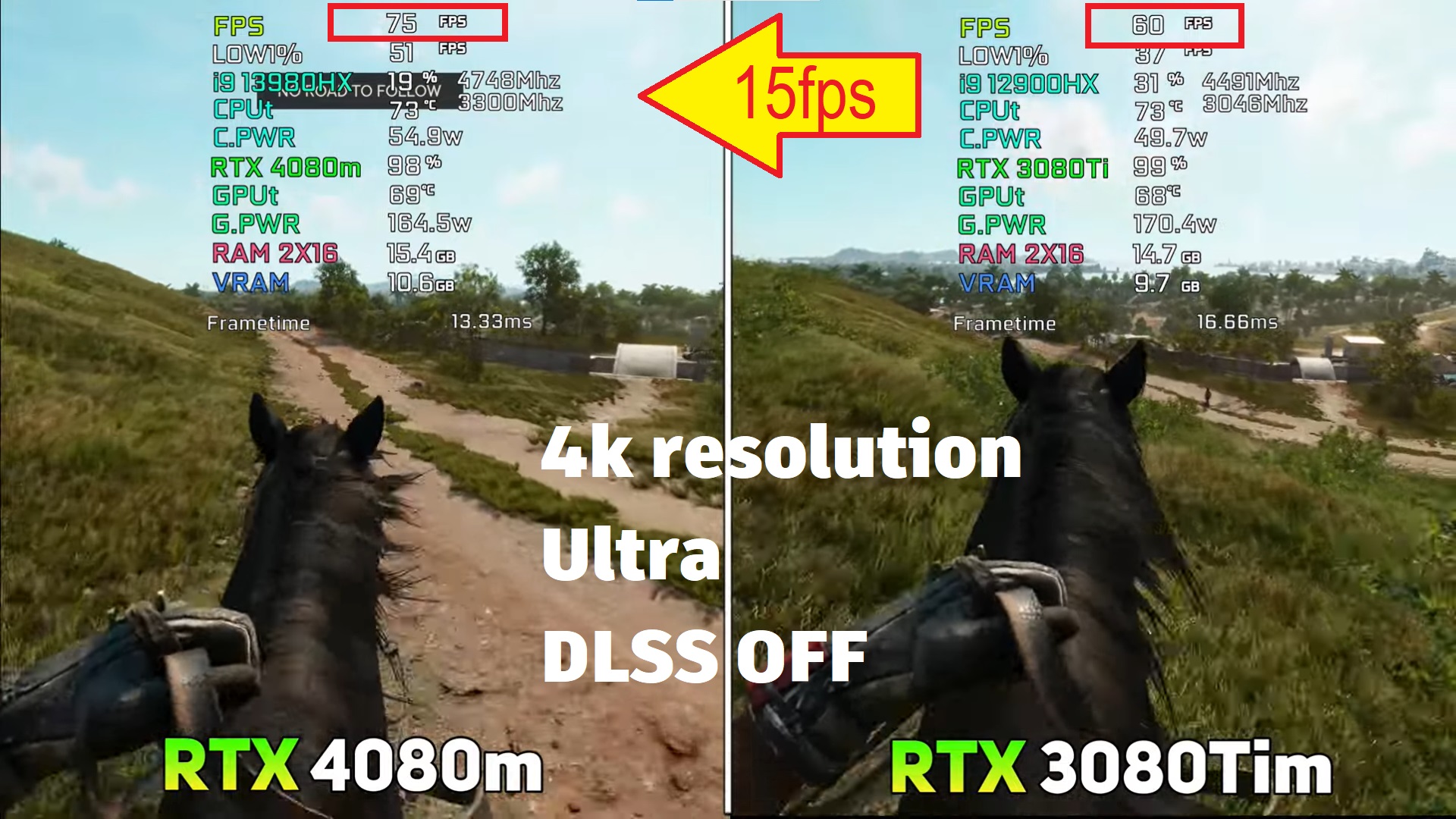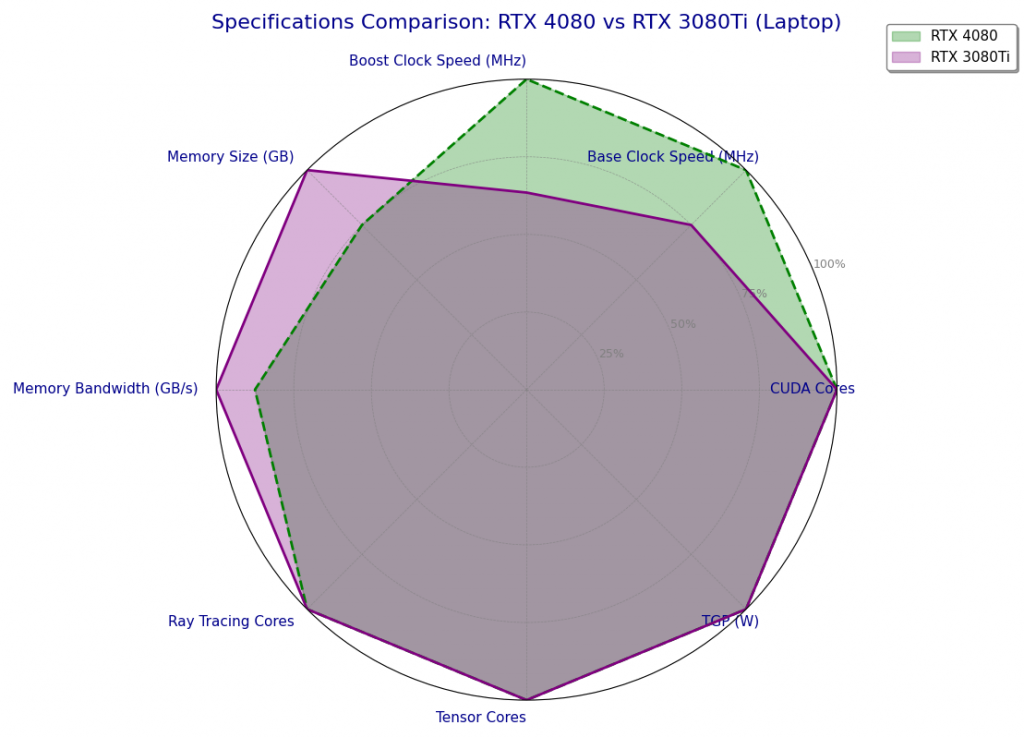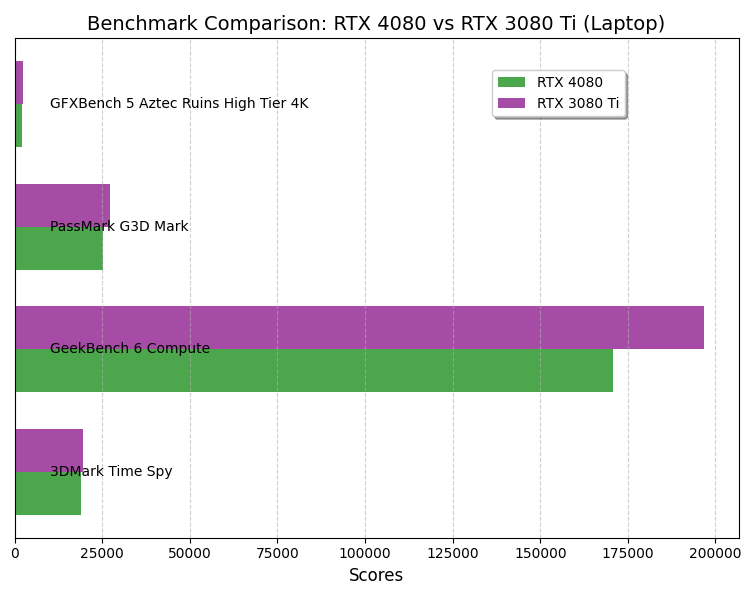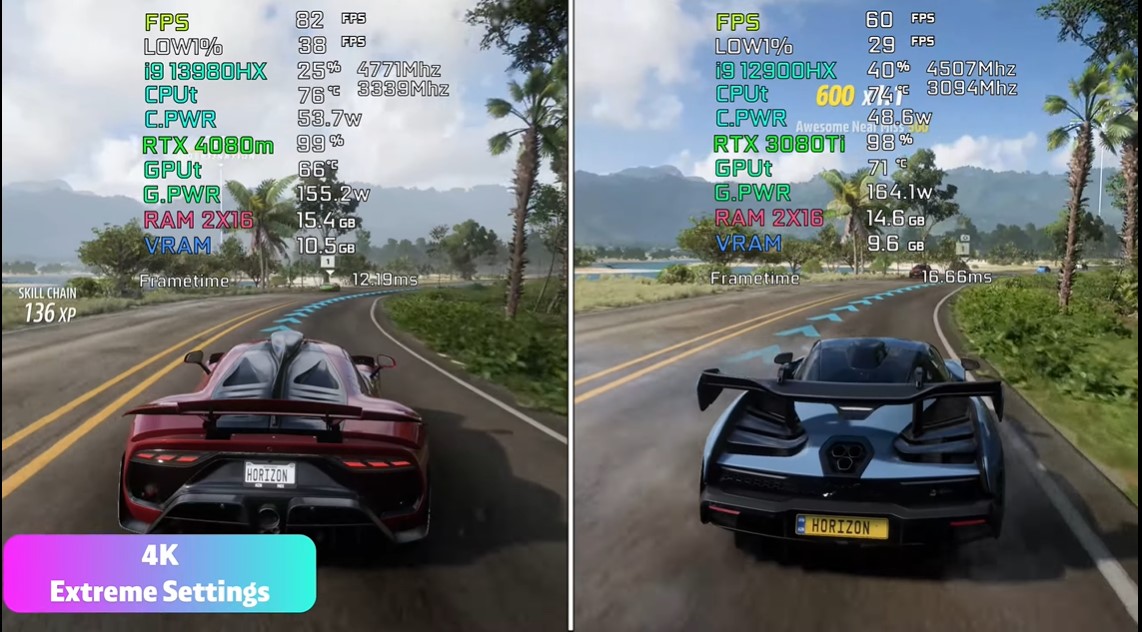TL;DR:

Gaming:
- If you’re running older or non-DLSS games at max settings, especially at 4K, the 4080 takes the lead anywhere from 10-15fps.
- If you’re playing modern, DLSS 3-optimized games, the RTX 4080 outperforms the 3080Ti by 15-30fps.
- Also on thin-and-light laptops or setups with limited cooling, the 4080 runs cooler and more consistently.
The 4080RTX is the clear winner in all aspects.
3D Modeling:
For heavy 3D rendering tasks (e.g., Blender Cycles, V-Ray) requiring high memory bandwidth and CUDA core counts, the RTX 3080 Ti performs better due to its 16GB VRAM and wider memory bus. However, in real-time workflows or tasks using AI-driven features like denoising, the RTX 4080 edges ahead with its newer architecture and Ada Lovelace optimizations.
Video Editing:
The RTX 4080 pulls ahead in 4K workflows, thanks to faster AI-accelerated effects and better timeline playback via DLSS 3 and Tensor cores. For 8K editing or heavy VRAM usage, the RTX 3080 Ti holds an edge due to its larger VRAM pool.
AI Tasks: The RTX 4080 dominates here, with its third-gen Tensor cores and efficiency in AI workloads like deep learning inference and image processing. Unless raw CUDA performance is needed for older AI models, the 4080’s modern architecture is the smarter choice.
1. Specs Comparison: 4080RTX (Laptop) vs 3080Ti (Laptop)

| Feature |
4080RTX (Laptop) |
3080Ti (Laptop) |
| Architecture |
Ada Lovelace (5nm) |
Ampere (8nm) |
| CUDA Cores |
7424 |
7424 |
| Tensor Cores |
232 (4th Gen) |
232 (3rd Gen) |
| RT Cores |
58 (3rd Gen) |
58 (2nd Gen) |
| Base Clock |
1920 MHz |
1440 MHz |
| Boost Clock |
2505 MHz |
1590 MHz |
| Memory Size |
12GB GDDR6 |
16GB GDDR6 |
| Memory Interface |
192-bit |
256-bit |
| Memory Bandwidth |
504 GB/s |
576 GB/s |
| TGP (Total Graphics Power) |
60W – 175W |
80W – 175W |
| DLSS Support |
DLSS 3 (with Frame Gen) |
DLSS 2 |
Important Nuances to Consider
TGP Variations
- What It Means: Both GPUs can go up to 175W, but the 4080RTX is more efficient thanks to Ada Lovelace architecture. Even at lower wattages (e.g., 80W), the 4080RTX holds its own, while the 3080Ti thrives when given all the power it can get.
- The Deal: If your laptop has limited cooling or lower TGP, the 4080RTX will perform better and run cooler. At 175W, both GPUs crush it, but the 3080Ti might edge out in raw memory-heavy tasks due to its wider memory bus.
CUDA Cores
- What It Means: Both GPUs pack 7424 CUDA cores, which means their raw compute power is comparable. However, the 4080RTX’s higher clock speeds give it an edge in processing-heavy tasks like real-time rendering.
- The Deal: CUDA-heavy tasks like Blender Cycles rendering or machine learning will perform similarly on both, but the 4080RTX is faster in apps that benefit from clock speed boosts.
Tensor Cores
- What It Means: Both GPUs have 232 Tensor cores, but the 4080RTX uses 4th-gen Tensor cores, which are optimized for AI tasks like DLSS 3, real-time denoising, and neural network inference.
- The Deal: In AI-assisted workflows (e.g., Topaz AI, Photoshop AI tools), the 4080RTX pulls ahead. The 3080Ti’s Tensor cores are solid but lack frame generation support.
RT Cores
- What It Means: Both GPUs are evenly matched with 58 RT cores, but the 4080RTX’s 3rd-gen RT cores are faster and more efficient, especially for real-time ray tracing.
- The Deal: If you’re gaming in Cyberpunk 2077 or working in Unreal Engine 5, the 4080RTX’s RT cores deliver smoother performance. The 3080Ti holds up well but doesn’t have the same level of optimization.
Memory Size
- What It Means: The 4080RTX has 12GB of VRAM, while the 3080Ti offers 16GB. This makes the 3080Ti better for memory-heavy applications like 4K gaming, 8K editing, or large-scale rendering.
- The Deal: If you’re working on projects or playing games that need more than 12GB of VRAM (e.g., Hogwarts Legacy, Flight Simulator), the 3080Ti is the safer bet.
Memory Interface and Bandwidth
- What It Means: The 3080Ti’s 256-bit bus gives it a bandwidth of 576 GB/s, compared to the 4080RTX’s 192-bit interface and 504 GB/s bandwidth.
- The Deal: The 3080Ti dominates in memory-bound tasks like high-res rendering or texture-heavy games. The 4080RTX’s smarter architecture narrows the gap in most modern applications.
Base and Boost Clocks
- What It Means: The 4080RTX’s clocks are much higher (1920 MHz base, 2505 MHz boost) compared to the 3080Ti’s 1440 MHz base and 1590 MHz boost.
- The Deal: For real-time workflows (e.g., video editing previews, Unreal Engine renders), the 4080RTX feels snappier and smoother.
DLSS Support
- What It Means: The 4080RTX supports DLSS 3 with frame generation, while the 3080Ti is limited to DLSS 2.
- The Deal: DLSS 3 lets the 4080RTX generate extra frames, making it a game-changer in modern games like Spider-Man: Miles Morales or Cyberpunk 2077. The 3080Ti is still solid, but it can’t keep up in DLSS 3-enabled titles.
The Takeaway
- 4080RTX:
- Perfect for modern gaming with DLSS 3, AI tasks, and efficient laptops.
- Ideal if you want better temps, lower power consumption, and future-proof features.
- 3080Ti:
- Better for VRAM-heavy workloads like 4K gaming and 8K rendering.
- Shines in laptops with high TGPs and robust cooling for maximum performance.
TL;DR: The 4080RTX crushes in efficiency and future-proof tech, while the 3080Ti is the choice for memory-bound tasks and raw performance at high power. If you’re all about new features and AI, go 4080RTX. If you need that extra VRAM, stick with the 3080Ti.
2. Benchmarks: 4080 RTX vs 3080Ti RTX

| Benchmark |
RTX 4080 Laptop GPU |
RTX 3080 Ti Laptop GPU |
Difference |
| 3DMark Time Spy Score |
18,894 |
19,626 |
-4% |
| GeekBench 6 Compute Score |
170,767 |
196,756 |
-13% |
| PassMark G3D Mark Score |
25,103 |
27,119 |
-7% |
| GFXBench 5 Aztec Ruins High Tier 4K (FPS) |
213.9 |
227.3 |
-6% |
Note: A negative difference indicates the RTX 4080 Laptop GPU scores lower than the RTX 3080 Ti Laptop GPU in that benchmark.
Important Nuances to Consider
TGP Variations
- The performance of both the RTX 4080 and RTX 3080 Ti Laptop GPUs heavily depends on their TGP configurations. At lower TGPs (e.g., 80W), the 4080RTX’s efficiency allows it to maintain stronger performance, while the 3080 Ti relies on higher TGPs (140W+) to fully utilize its raw power. Benchmarks comparing these GPUs often don’t clarify the TGP settings used, which can lead to misleading conclusions.
Cooling System
- Cooling plays a huge role in sustained performance. The 3080 Ti, with its higher memory bandwidth and raw compute power, is more susceptible to thermal throttling, especially in laptops with poor cooling. The 4080RTX is better optimized for efficiency, so it’s less impacted by weaker thermal solutions. When interpreting benchmarks, consider the laptop’s cooling capabilities, as it can swing results significantly.
CPU Pairing
- Benchmarks don’t always account for CPU bottlenecks. A lower-end CPU might hurt the 3080 Ti’s performance advantage, especially in tasks that require both high GPU and CPU power (e.g., gaming or rendering). The 4080RTX’s newer architecture can often mitigate these issues better, making it a more balanced choice for mid-range CPUs.
Benchmark Discussions
3DMark Time Spy
- What It Tests: Measures DirectX 12 gaming performance, simulating real-world gaming scenarios.
- The Results: The 3080 Ti scores 4% higher, showing slightly better raw performance, especially at high TGPs where it can flex its 256-bit memory interface.
- How Nuances Impact This: At lower TGPs (e.g., 80-100W), the 4080RTX outperforms due to its efficiency. In laptops with limited cooling, the 4080RTX maintains more stable performance, whereas the 3080 Ti may throttle.
- Should You Care?: If you’re gaming at 1440p or 4K without DLSS, the 3080 Ti’s raw power gives it a slight edge. But if you’re using DLSS 3, the 4080RTX catches up or overtakes the 3080 Ti. TL;DR: Go 4080RTX for DLSS-heavy games or laptops with less cooling; stick with the 3080 Ti for pure brute force at high TGPs.
GeekBench 6 Compute
- What It Tests: Focuses on raw compute power, ideal for CUDA-heavy workloads like simulations and rendering.
- The Results: The 3080 Ti scores 13% higher, leveraging its wider memory bus and higher memory bandwidth.
- How Nuances Impact This: At low TGPs, the 4080RTX holds up well, thanks to its higher clock speeds and architectural improvements. However, at high TGPs, the 3080 Ti takes full advantage of its design and edges out the 4080RTX.
- Should You Care?: For CUDA-heavy tasks like simulations or big data processing, the 3080 Ti is stronger. However, for AI-assisted tasks, the 4080RTX’s newer Tensor cores make it the more efficient option. TL;DR: 3080 Ti for raw compute; 4080RTX for AI-based workflows.
PassMark G3D Mark
- What It Tests: A general-purpose benchmark for gaming and productivity.
- The Results: The 3080 Ti scores 7% higher, thanks to its higher memory bandwidth and raw compute power.
- How Nuances Impact This: Lower-TGP laptops favor the 4080RTX, as it maintains consistent performance even with less power and cooling. In high-TGP configurations, the 3080 Ti pulls ahead, but only if the laptop can handle the extra heat and power draw.
- Should You Care?: For gaming and lighter workloads, the differences are minimal. For 4K gaming or large-scale projects, the 3080 Ti’s raw power can make a difference. TL;DR: If you’re not constrained by TGP or cooling, the 3080 Ti is the better choice; otherwise, go with the 4080RTX.
GFXBench 5 Aztec Ruins High Tier 4K
- What It Tests: Simulates 4K rendering workloads, testing memory bandwidth and raw rendering power.
- The Results: The 3080 Ti scores 6% higher, showcasing its superior memory interface in handling complex textures and large data sets.
- How Nuances Impact This: At low TGPs, the 4080RTX performs more consistently, while the 3080 Ti struggles with throttling. High TGPs (140W+) allow the 3080 Ti to leverage its memory bandwidth advantage.
- Should You Care?: For 4K rendering in tools like Unreal Engine or texture-heavy games, the 3080 Ti wins. For real-time rendering or AI-accelerated workflows, the 4080RTX’s efficiency and newer architecture make it more competitive. TL;DR: The 3080 Ti dominates in memory-heavy tasks, while the 4080RTX feels snappier in modern workflows.
3. Performance : 3080Ti vs 4080RTX
 Gaming
Gaming
High-TGP Configurations (175W RTX 4080 vs. 175W RTX 3080 Ti)
- Without DLSS: The RTX 4080RTX is the champ despite the lack of vRAM and lower memory bus and bandwidth, it crushes the 3080Ti RTX.
- With DLSS: This is where the RTX 4080 flexes its architectural efficiency even more. With DLSS 3 and frame generation, it gives you a significant edge over the 3080Ti.
- At Max TGP: The RTX 4080 pulls ahead in DLSS-heavy scenarios while running cooler and more efficiently than the 3080 Ti. This makes it a solid option for long gaming sessions without cooking your laptop.
- TL;DR: If you’re playing games that don’t use DLSS, the RTX 3080 Ti is a good option as there’s only a 10-15 fps difference. But for modern DLSS 3-optimized titles, the RTX 4080 can deliver FAR more framerates while sipping less power.
Low-TGP Configurations (80W RTX 4080 vs. 150W RTX 3080 Ti)
- Without DLSS: The RTX 3080 Ti wins in raw power, but this is where cooling and throttling start to matter. A 150W 3080 Ti in a poorly cooled system might not reach its potential, while the 4080 can keep steady due to its efficiency.
- Example: In Hogwarts Legacy or Ratchet & Clank, the 3080 Ti’s 16GB VRAM is great for massive textures, but its edge can diminish if the laptop’s cooling isn’t up to the task.
- With DLSS: The RTX 4080’s Ada Lovelace architecture shines in these setups. Even at 80W, DLSS 3 and frame generation help it punch above its weight. It’s far more consistent in thin-and-light laptops or thermally constrained environments.
Note: If you’re using a thin-and-light laptop or prioritize consistent frame rates in DLSS-optimized games, the RTX 4080 is the clear winner. On the flip side, the RTX 3080 Ti thrives in laptops with robust cooling and higher power budgets.
TL;DR: Grab the RTX 4080 if you’re gaming on modern, DLSS-heavy titles or in a thin-and-light laptop. Stick with the RTX 3080 Ti if you want raw power for older, non-DLSS games and have a laptop that can handle its thermal demands.
Video Editing
High-TGP Configurations
- The RTX 3080 Ti excels in 8K video editing workflows, handling large project files and heavy GPU acceleration better due to its wider memory bus and 16GB VRAM.
- Example: Rendering a heavily edited 10-minute 8K video is faster on the RTX 3080 Ti in tools like DaVinci Resolve.
- The RTX 4080 is more competitive in 4K editing workflows, especially when using AI-accelerated tools like Adobe Sensei, which benefit from Ada Lovelace’s improved efficiency and Tensor cores.
- Example: Applying GPU-accelerated effects and rendering in Adobe Premiere Pro can be faster on the RTX 4080.
- TL;DR: Choose the RTX 3080 Ti for 8K editing or VRAM-heavy projects. Pick the RTX 4080 for 4K workflows and AI-assisted tools.
Low-TGP Configurations
- The RTX 4080 maintains better performance in light editing tasks (e.g., 1080p to 4K) due to its architectural efficiency, especially in laptops with constrained cooling.
- The RTX 3080 Ti may struggle in these scenarios, as thermal throttling can reduce its VRAM and bandwidth advantage.
- TL;DR: RTX 4080 wins in constrained setups or lighter editing workflows.
3D Rendering and Modeling
High-TGP Configurations
- The RTX 3080 Ti excels in memory-intensive rendering tasks like Blender Cycles or V-Ray, leveraging its higher CUDA core count and wider memory bandwidth.
- Example: Rendering a complex scene in Blender is faster on the RTX 3080 Ti.
- The RTX 4080 is more efficient in real-time rendering and AI-assisted tasks like denoising or DLSS 3-supported visualization.
- Example: Real-time previews and rendering in Unreal Engine 5 benefit from the RTX 4080’s Ada Lovelace features.
- TL;DR: For memory-heavy workloads, the RTX 3080 Ti shines. For real-time rendering and AI-accelerated tasks, the RTX 4080 is better.
Low-TGP Configurations
- The RTX 4080 performs consistently well in low-power scenarios, excelling in AI-assisted workflows and light 3D modeling.
- The RTX 3080 Ti loses its edge due to higher power demands and potential throttling in less-cooled laptops.
- TL;DR: RTX 4080 is the better choice for constrained environments.
AI-Assisted Applications
High-TGP Configurations
- The RTX 4080 benefits from 4th-gen Tensor cores and Ada Lovelace optimizations, making it ideal for tasks like deep learning inference and AI image enhancement.
- Example: Using Topaz AI or Adobe’s Super Resolution runs faster on the RTX 4080.
- The RTX 3080 Ti’s higher Tensor core count makes it strong in traditional AI workloads like neural network training, where core count is critical.
- Example: Training a neural network may be faster on the RTX 3080 Ti.
- TL;DR: RTX 4080 for inference and modern AI tasks; RTX 3080 Ti for traditional training workloads.
Low-TGP Configurations
- The RTX 4080’s efficiency makes it the clear winner for AI workflows in constrained environments.
- The RTX 3080 Ti struggles with throttling and reduced efficiency in low-power setups.
- TL;DR: RTX 4080 dominates here.
General GPU Performance
High-TGP Configurations
- The RTX 3080 Ti excels in memory-bound tasks like 4K rendering or large simulations, while the RTX 4080 leads in modern, optimized applications leveraging DLSS 3 and AI features.
- TL;DR: Pick the 3080 Ti for brute-force performance; choose the 4080 for modern efficiency.
Low-TGP Configurations
- The RTX 4080 is more consistent and reliable in thermally constrained setups, offering better efficiency and sustained performance.
- The RTX 3080 Ti struggles in these scenarios, making the 4080 a better all-around choice for low-power laptops.
- TL;DR: RTX 4080 wins in constrained environments
4. Conclusions
- Performance Uplift
- The RTX 4080 (Laptop) delivers approximately 20-30% better performance than the RTX 3080 Ti in most scenarios, especially in modern games that leverage Ada Lovelace architecture optimizations such as DLSS 3 and frame generation.
- Without DLSS or frame generation, the performance uplift narrows, particularly at 4K resolutions, where the RTX 3080 Ti’s 16GB VRAM and wider memory bandwidth excel in handling large textures and memory-intensive tasks.
- Efficiency and Cooling
- The RTX 4080’s smaller die size (AD104) and Ada Lovelace efficiency allow it to fit into sleeker chassis with improved thermals. It consumes less power compared to the RTX 3080 Ti’s GA103S, which operates at higher wattages, often requiring bulkier cooling solutions.
- For thermally constrained environments, the RTX 4080 offers better power efficiency and sustained performance. The RTX 3080 Ti, while powerful, is more prone to throttling in less robust laptops.
- Gaming
- In modern AAA titles with DLSS 3 and frame generation enabled, the RTX 4080 can match or exceed the RTX 3080 Ti’s performance at 1440p and 1080p.
- At 4K resolutions or in poorly optimized games, the RTX 3080 Ti’s 16GB VRAM and higher memory bandwidth offer an advantage, especially in non-DLSS scenarios.
- Takeaway: Gamers focused on modern DLSS-optimized titles should lean toward the RTX 4080. For non-DLSS workloads or VRAM-heavy games, the RTX 3080 Ti still holds its ground.
- Video Editing and 3D Rendering
- The RTX 4080 benefits from Ada Lovelace optimizations for AI-assisted tools and real-time rendering workflows, making it more efficient for 4K video editing and AI-driven tasks.
- The RTX 3080 Ti excels in memory-bound rendering tasks, such as Blender Cycles or V-Ray, where its wider memory bus and higher VRAM play a critical role.
- Takeaway: For professionals focused on real-time previews and AI-assisted workflows, the RTX 4080 is ideal. The RTX 3080 Ti remains a better choice for large-scale 3D rendering or 8K video projects requiring more VRAM.
- Value for Money
- Cost Considerations: Many comments point out that RTX 4080 laptops are often cheaper than RTX 3080 Ti laptops were at launch, making the new-gen upgrade more appealing. However, the RTX 3080 Ti still offers excellent performance and may be available at discounted prices in some markets.
- Future-Proofing: The RTX 4080, with its support for DLSS 3 and improved efficiency, is better suited for long-term use in modern gaming and productivity workloads.
- Upgrade Worthiness
- Upgrade Justification: If you’re coming from an older GPU or need DLSS 3 and frame generation for gaming, the RTX 4080 is a strong upgrade. For users focused on VRAM-heavy applications or gaming at 4K without DLSS, sticking with the RTX 3080 Ti may make more sense, especially if already owned.
- For those upgrading from a 30-series GPU (e.g., 3080 Ti), the performance uplift alone (20-30%) may not justify the cost, especially for users who don’t rely on DLSS 3 or need additional VRAM.
Author Profile
-
Miguel Salas
-
I am physicist and electrical engineer. My knowledge in computer software and hardware stems for my years spent doing research in optics and photonics devices and running simulations through various programming languages. My goal was to work for the quantum computing research team at IBM but Im now working with Astrophysical Simulations through Python. Most of the science related posts are written by me, the rest have different authors but I edited the final versions to fit the site's format.



 Gaming
Gaming LaptopsNovember 26, 2025Black Friday Week Deals 2025 (Updated Nov 28 1:37PM)!!!
LaptopsNovember 26, 2025Black Friday Week Deals 2025 (Updated Nov 28 1:37PM)!!! LaptopsJune 30, 2025Best Laptops for Computer Science (July 2025 )
LaptopsJune 30, 2025Best Laptops for Computer Science (July 2025 ) LaptopsJune 29, 20255 Best Laptops For Nursing Students (July 2025)
LaptopsJune 29, 20255 Best Laptops For Nursing Students (July 2025) LaptopsJune 19, 20255 Best Laptops For Teachers in 2025 (From $250)
LaptopsJune 19, 20255 Best Laptops For Teachers in 2025 (From $250)